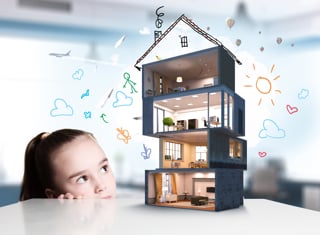IEQ finally enters the EPBD
– Linking energy performance and indoor environment

In the year 2025, energy efficiency and indoor environmental quality are under one framework. Finally, it happened, IEQ is now firmly implemented in the heart of the European legislative agenda for better energy efficiency and promotes a healthy, comfortable and productive indoor environment for all. And IEQ – with its definition in Article 2 – is now a fundamental component of the EPBD's broader goals, thereby improving energy performance while providing comfortable environments for people living and working in buildings.
Establishing the IEQ definition and IEQ parameters to monitor
The Energy Performance of Buildings Directive (EPBD) is a key legislative measure from the European Union aimed at improving energy efficiency of buildings across Member States. The EPBD establishes a framework for reducing energy consumption and greenhouse gas emissions associated with the built environment, thereby contributing to the EU's overall climate goals of achieving a carbon-neutral economy by 2050.
IEQ is part of Articles 2, 5, 7, 8 and 13 in the EPBD, with the primary definition in Article 2.
"Indoor environmental quality means the result of an assessment of the conditions inside a building that influence the health and well-being of its occupants, based upon parameters such as those relating to the temperature, humidity, ventilation rate and presence of contaminants."
The definition lists several IEQ factors as the basis for minimum monitoring for national standards. However, these parameters are not comprehensive, and the definition needs to be further reinforced by the national guidelines. To ensure optimal indoor environments, guidelines like EN 16798-1 and other European frameworks for sustainable buildings recommend monitoring specific IEQ parameters, defined as temperature, ventilation rates, relative humidity, CO2 levels, VOCs, particulate matter PM2.5, lighting and daylight illuminance, and acoustics with sound pressure and reverberation time.
Recognising the importance of indoor environment monitoring
Article 13 sets the requirements for controlling IEQ parameters.
"Member States shall set requirements for the implementation of adequate indoor environmental quality standards in buildings in order to maintain a healthy indoor climate."
"Member States shall require non-residential zero-emission buildings to be equipped with measuring and control devices for the monitoring and regulation of indoor air quality. In existing non-residential buildings, the installation of such devices shall be required, where technically and economically feasible, when a building undergoes a major renovation. Member States may require the installation of such devices in residential buildings."
"The building automation and control systems shall be capable of: (d) by 29 May 2026, monitoring of indoor environmental quality."
In prioritising the maintenance of a healthy indoor climate for building occupants, policymakers are urging cooperation among all related stakeholders, including facility management and building representatives, to set performance levels for the key IEQ parameters described above. These parameters should be adapted to different building types and activities. Benchmarks of acceptable indoor air quality and thermal comfort in buildings can also lead to selected targets using recognisable labelling and indexing.
Non-residential zero-emission buildings shall be equipped with measuring and controlling devices for monitoring, communication and regulation of the indoor environment. Existing non-residential buildings should aim to have such systems if technically and economically feasible. And the ultimate goal in the future would be to have such systems also in residential buildings.
Many HVAC systems installed today in newly built buildings are already equipped with the commonly available monitoring functionalities and the integrated controls of mechanical ventilation systems, and all control systems are already connected to technical building automation systems. This is an easy advantage to meet IAQ requirements. Further plans should include actions on how the monitored data can be made visible/available and communicated to all relevant parties.
Many more Articles in EPBD dealing with IEQ and ventilation
In total, at least ten different Articles in the EPBD recast explicitly address IEQ, ventilation and/or indoor environmental quality (Articles 1, 2, 5, 7, 8, 13, 15, 19, 20, 23), and even more Articles address the energy performance of buildings. Some Articles are focusing on defining a scope or set a definition (Article 1&2), others are aiming at setting minimum design/performance requirements (5), ensuring IEQ in relation to new buildings and renovations (7, 8). Others are zooming in on monitoring and controls, systems and regulations (13), smart readiness of buildings (15), and, last but not least, some are focusing on information and certifications (19, 20, 23).
In sum, IEQ is now embedded in the EPBD in multiple places, not just defined, but tied into energy performance, monitoring, certificates, etc. This is far more comprehensive than earlier versions of the Directive.
Key lessons from the EPBD on how IEQ and energy are intertwined
The reasoning is simple and based on a balance. The primary purpose of a building is to provide a safe shelter from the external environment and maintain a comfortable and healthy indoor climate. The indoor environment is evaluated in terms of indoor air quality (IAQ), thermal comfort, lighting and acoustic conditions. The building's performance is assessed by energy performance certificates (EPCs).
And here is why IEQ and energy as a duo must never be split, and forever must be treated as equals.
- IEQ can majorly affect a building's energy performance.
- Energy performance cannot be defined without also setting the required IEQ level.
- A good IEQ cannot be achieved in a poorly performing building.
- When assessing building energy performance, IEQ as a key input must be explicitly included.
- Using cost-benefit analysis, minimum IEQ levels can provide the best environment for increased productivity, enhanced learning and improved health.
- Reporting IEQ parameters is directly connected to energy results.
- Without reporting actual IEQ parameters achieved in buildings, the energy balance and performance comparability cannot be assessed correctly.
- Energy performance and indoor environmental quality only become apparent and visible through the achieved results.
- Indoor environmental quality and energy-efficient solutions directly contribute to the resilience of buildings against the impacts of climate change.
More information
There is more to know about the recent changes in the EPBD and indoor environmental quality (IEQ) in buildings and we will therefore continue to publish knowledge on the topic in the coming months. In the meantime, visit Swegon Air Academy and sign up for our monthly newsletter.




